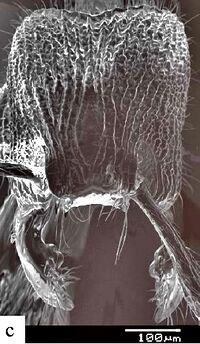Myrmecina gracilis
| Myrmecina gracilis | |
|---|---|

| |
| Scientific classification | |
| Kingdom: | Animalia |
| Phylum: | Arthropoda |
| Class: | Insecta |
| Order: | Hymenoptera |
| Family: | Formicidae |
| Subfamily: | Myrmicinae |
| Tribe: | Crematogastrini |
| Genus: | Myrmecina |
| Species complex: | gracilis |
| Species: | M. gracilis |
| Binomial name | |
| Myrmecina gracilis Okido, Ogata & Hosoishsi, 2020 | |
This species inhabits the soil.
Identification
Okido, Ogata, and Hosoishi (2020) - A member of the M. gracilis complex. Among these species, M. gracilis is distinguished by a long head and a sculptured first gastral sternum with an anterior median ridge.
Keys including this Species
Distribution
Distribution based on Regional Taxon Lists
Indo-Australian Region: Indonesia, Malaysia (type locality).
Distribution based on AntMaps
Distribution based on AntWeb specimens
Check data from AntWeb
Countries Occupied
| Number of countries occupied by this species based on AntWiki Regional Taxon Lists. In general, fewer countries occupied indicates a narrower range, while more countries indicates a more widespread species. |

|
Biology
Castes
Nomenclature
The following information is derived from Barry Bolton's Online Catalogue of the Ants of the World.
- gracilis. Myrmecina gracilis Okido, Ogata & Hosoishsi, 2020: 44, fig. 18 (w.) MALAYSIA.
Unless otherwise noted the text for the remainder of this section is reported from the publication that includes the original description.
Description
Holotype. TL 2.53 (excluding mandible length), HL 0.66, HW 0.56, CI 85, SL 0.50, SI 89, PW 0.43, ML 0.66. Paratype. TL 2.30-2.90, HL 0.55-0.70, HW 0.50-0.62, CI 86-95, SL 0.38-0.51, SI 75-88, PW 0.37-0.48, ML 0.59-0.75 (9 measured).
Head subrectangular, longer than broad in full-face view; lateral margin more or less straight; median portion of occipital margin distinctly concave; occipital corners rounded, not projected posteriorly. Masticatory margin of mandible bent at midlength (third small tooth or sixth tooth); apical tooth strong, third tooth robust, followed by 5 small teeth and a basal blunt tooth; small teeth and a basal tooth unclear. Dorsal surface of clypeus distinctly concave; median portion of anterior margin slightly projected and concave without median process; lateral portion simple, lacking sharp ridge in front of antennal insertions. Anterior dorsal surface of labrum with paired small denticles distinctly. Frontal carinae present, running to near occipital corners; frequently indistinguishable from rugae on dorsum of head. Eyes very small and moderately convex, varying in size with maximum diameter 0.05-0.06 mm and 4-7 ommatidia. Antennal scape short, not reaching posterolateral corner of head; antennal flange not developed.
Dorsal outline of mesosoma flattened or slightly convex in profile. Pronotum with very small denticles in dorsolateral portion; anterior portion not marginate; anterior ventrolateral portion usually not angulate, but sometimes angulate. Eumetanotal spine present but small. Propodeal spine elongate and weakly curved upward, extending over vertical posteriormost limit of propodeum in profile. Propodeal lobe low. Propodeal spiracle usually large, situated near posterior margin of propodeum, distance between posterior margin of spiracle and posterior margin of propodeum shorter than diameter of spiracle. Petiole slightly long, slightly longer than high in profile, and longer than broad in dorsal view; midpoint of both lateral margins concave in dorsal view, but varying; small but distinct dorsal crest located at midlength in profile; anterior portion of subpetiolar process much developed with acute anterior apex. Postpetiole broader than petiole in dorsal view; anterior portion sometimes sharply raised in profile; ventral outline slightly projected.
Anterior margin of gaster concave in dorsal view; first gastral sternum forming a median longitudinal ridge distinctly on anterior central surface.
Head punctured with thin rugae longitudinally; ventrolateral portion punctured with thin rugae. Clypeus smooth and shining. Mesosoma punctured with thin rugae parallely. Forecoxa smooth and shining. Petiole and postpetiole punctured with unclear irregular rugae. First gastral tergum punctured distinctly. First gastral sternum feebly rugulose or punctured. Head with dense and short pilosity on dorsum. Mesosoma with dense and short pilosity on dorsum, hairs of pronotum shorter than propodeal spine. Longest dorsal pilosity of petiole as long as propodeal spine. Petiole without hairs on ventral surface. Postpetiole without hairs on ventral surface. Body black or dark reddish brown, mandibles, antennae and legs yellowish brown.
Type Material
Holotype worker, MALAYSIA: Sayap Kinabalu, ca. 1000 m alt., Sabah, Borneo (K. Eguchi) (Universiti Malaysia Sabah). Paratypes. 4 workers, MALAYSIA: Sarawak, 4th Division, Gn. Mulu NP., 8. ii. 78 or ii. 78 or v-vii. 1978 (N. M. Collins; P. M. Hammond & J. E. Marshall); 1 worker, Sabah, Kinabalu, 1500 m, 25. iv. 87 (Burckhardt & Löbl); 2 workers, Sabah, Crocker Ra. NP., KK-Tambunan, 1270 m, 17. v. 87 (Burckhardt & Löbl); 1 worker, Sabah, Kibongol Valley, 7 km N. Tambunan (Löbl & Burckhardt); 2 workers, Sabah, Gn. Silam, 620 m, 1983 (R. Leakey) (The Natural History Museum.
References
- Aswaj, P., Anoop, K., Priyadarsanan, D.R. 2021. Description of two new species of ants of the genus Myrmecina Curtis, 1829 (Hymenoptera: Formicidae: Myrmicinae) from the Eastern Himalayas. Zootaxa 4990, 160–171 (doi:10.11646/zootaxa.4990.1.10).
- Okido, H., Ogata, K., Hosoishsi, S. 2020. Taxonomic revision of the ant genus Myrmecina in Southeast Asia (Hymenoptera: Formicidae). Bulletin of the Kyushu University Museum. 7:1-108.
